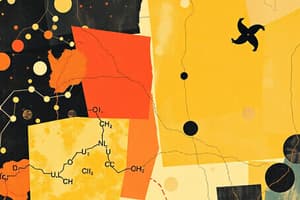Podcast
Questions and Answers
Which type of fatty acid chain has 13 or more carbons?
Which type of fatty acid chain has 13 or more carbons?
- Saturated fatty acids
- Short chain fatty acids
- Medium chain fatty acids
- Long chain fatty acids (correct)
What happens when an 'OH' from the glycerol molecule binds to an 'H' from the fatty acid?
What happens when an 'OH' from the glycerol molecule binds to an 'H' from the fatty acid?
- A diglyceride is formed
- A monoglyceride is formed
- A water molecule is released (correct)
- A triglyceride is formed
Why are triglycerides with saturated fatty acids usually solid at room temperature?
Why are triglycerides with saturated fatty acids usually solid at room temperature?
- They have a three carbon backbone
- They have a medium chain of fatty acids
- They have a long chain of fatty acids
- They have as many hydrogen atoms as possible (correct)
Which enzyme breaks down triglycerides into free fatty acids and monoglycerides in the saliva, stomach, and pancreas?
Which enzyme breaks down triglycerides into free fatty acids and monoglycerides in the saliva, stomach, and pancreas?
What is the function of bile salts in the digestion of fats?
What is the function of bile salts in the digestion of fats?
Where do fatty acids and monoglycerides reassemble into triglycerides?
Where do fatty acids and monoglycerides reassemble into triglycerides?
What is the recommended range for daily fat consumption according to the National Academies of Medicine?
What is the recommended range for daily fat consumption according to the National Academies of Medicine?
Which type of fatty acid is not saturated with hydrogen atoms?
Which type of fatty acid is not saturated with hydrogen atoms?
What is the omega number for a fatty acid with a double bond 6 carbons from the end?
What is the omega number for a fatty acid with a double bond 6 carbons from the end?
Which type of fatty acid is typically monounsaturated and can be made by the human body?
Which type of fatty acid is typically monounsaturated and can be made by the human body?
What is the result of partial hydrogenation of liquid oils?
What is the result of partial hydrogenation of liquid oils?
Flashcards are hidden until you start studying
Study Notes
Fatty Acid Chains
- Long-chain fatty acids have 13 or more carbons.
Triglyceride Formation
- When an 'OH' from the glycerol molecule binds to an 'H' from the fatty acid, an ester bond is formed.
Characteristics of Triglycerides
- Triglycerides with saturated fatty acids are usually solid at room temperature because the straight-chain fatty acids can pack together tightly.
Digestion of Triglycerides
- Lipase is the enzyme that breaks down triglycerides into free fatty acids and monoglycerides in the saliva, stomach, and pancreas.
Function of Bile Salts
- Bile salts emulsify fats, breaking them down into smaller droplets, increasing the surface area for lipase to act on.
Reassembly of Triglycerides
- Fatty acids and monoglycerides reassemble into triglycerides in the small intestine.
Daily Fat Consumption
- The recommended range for daily fat consumption is 20-35% of total daily calories, according to the National Academies of Medicine.
Unsaturated Fatty Acids
- Polyunsaturated fatty acids are not saturated with hydrogen atoms.
Omega Fatty Acids
- A fatty acid with a double bond 6 carbons from the end has an omega-6 designation.
Monounsaturated Fatty Acids
- Oleic acid is a monounsaturated fatty acid that can be made by the human body.
Partial Hydrogenation
- The result of partial hydrogenation of liquid oils is the formation of trans fats.
Studying That Suits You
Use AI to generate personalized quizzes and flashcards to suit your learning preferences.




